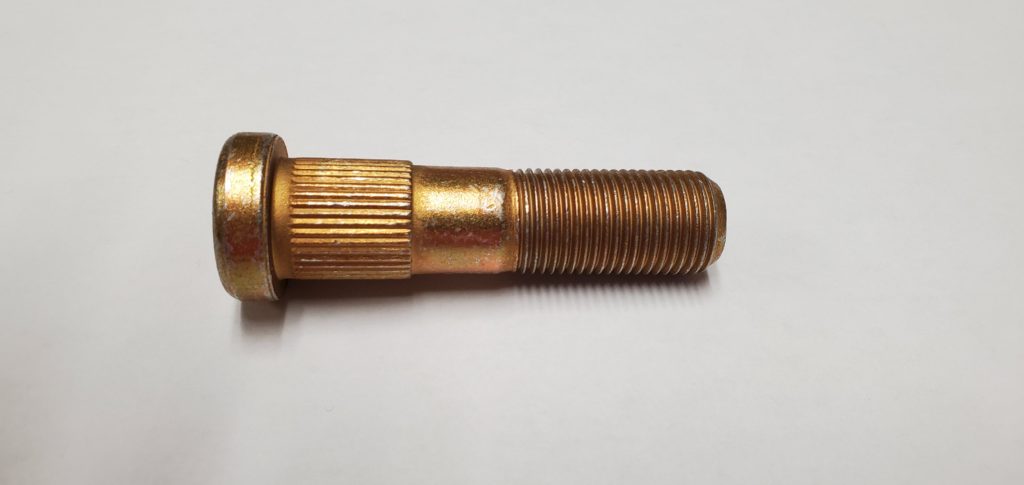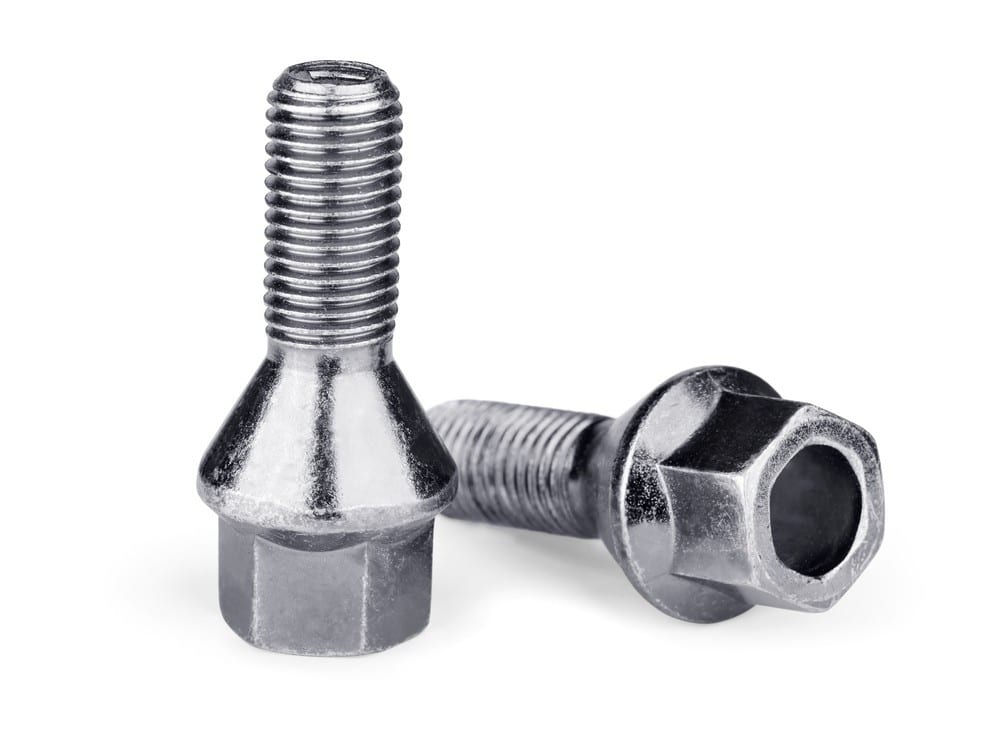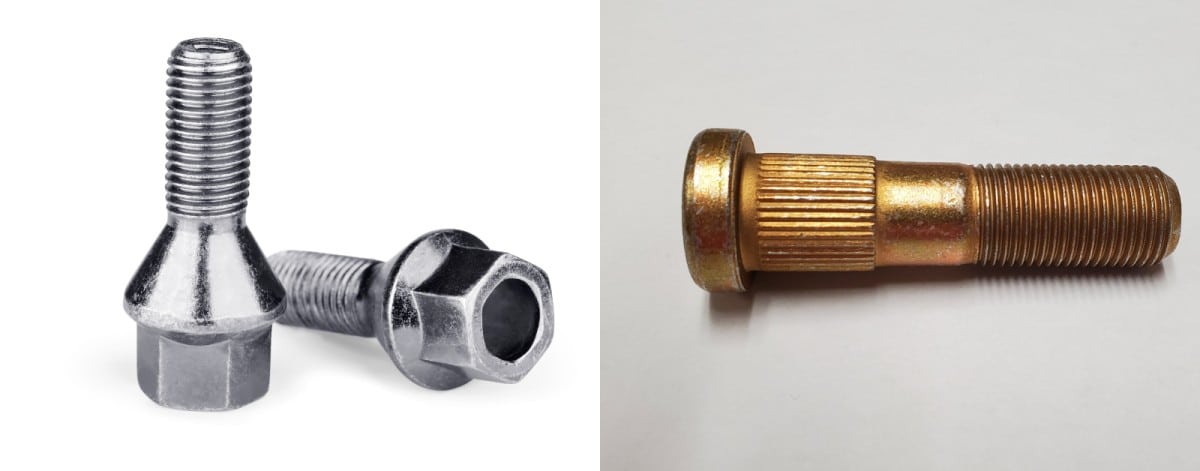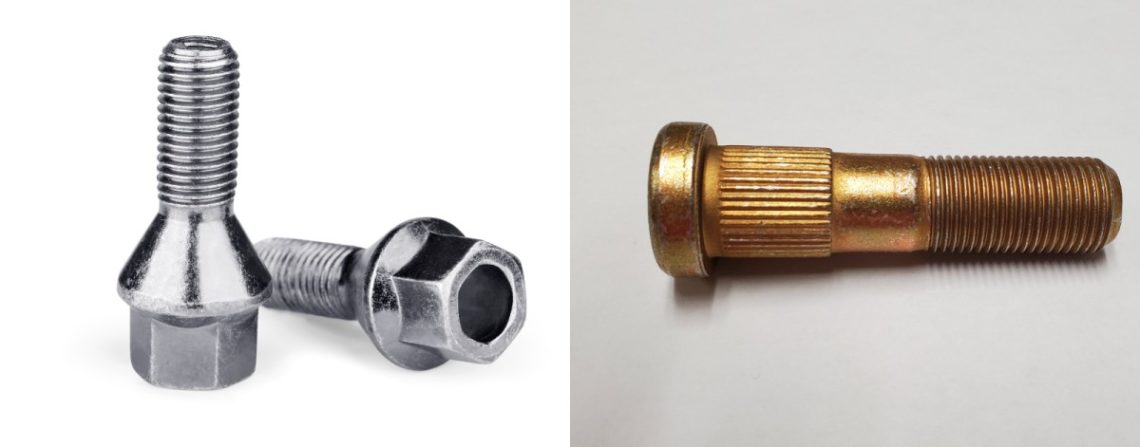Most wheels are attached to vehicles using either wheel studs or wheel bolts. So what’s the difference between these two automotive fasteners, and what impacts could those differences have on vehicle performance?
Let’s take a closer look into wheel studs vs. wheel bolts below.
What Are Wheel Studs and Wheel Bolts?
Wheel studs have a threaded shaft, an unthreaded body, a ribbed neck (usually), and a flat head that’s usually round (but not always). Yes, there are a few ifs and usuallys in that sentence, but that’s the complex nature of the fastener industry for you.
Wheel studs are usually pressed into the hole, where the ribbing grips the hole and holds them in place. The threaded parts of the studs don’t engage with the hole. They’re then paired with lug nuts.
Every characteristic listed above describes the most popular type of wheel stud: press-in. However, there is another type of wheel stud that is used pretty commonly as well: screw-in.
Screw-in wheel studs are a bit different and a little less common. They have a continuously threaded shaft all the way up to the head, which is usually a hex head. They’re installed by screwing them directly into the hole where the threads directly engage the hole and holding them in place.

Wheel bolts also have a threaded shaft and a tapered head that matches a vehicle’s wheel insert. However, they go in through the wheel insert, through the brake rotor hat, and straight to the hub, locking everything in place. They aren’t generally paired with nuts.

RELATED: Need a specialty bolt, screw, or stud? Wilson-Garner can help.
Wheel Studs vs. Wheel Bolts: The Key Differences
While both wheel studs and wheel bolts serve the same general purpose — holding wheels onto vehicles — there are some key differences between them, such as their insertion method, their ease of use, where they’re commonly used, and the number of additional parts required for installation. We’ll look at a few of these differences below.
Wheel Studs
Here’s the rundown on wheel studs:
- Insertion method — As mentioned previously, wheel studs are mounted in the wheel hub, stick out beyond the brake rotor hat, and are then paired with lug nuts.
- Ease of use — Wheel studs stay in place when you remove a vehicle tire, so you don’t have to go through the process of realigning everything upon replacement. This makes for quick and simple tire changes. However, wheel studs can be a pain to replace because you have to get them back out of the hole they were pressed into without destroying the wheel hub.
- Where they’re used — Wheel studs are the most popular choice for American automotive manufacturers.
- Additional parts required — Wheel studs need to be paired with nuts, so you have to purchase and obtain those additional parts. However, the nuts do help wheel studs maintain more consistent torque.
Wheel Bolts
Conversely, here’s how wheel bolts differ:
- Insertion method — Wheel studs are installed from behind the wheel hub and attached with lug nuts on the front, but wheel bolts are installed in the wheel insert from the front, through the brake rotor hat and directly into the hub.
- Ease of use — When wheel bolts are removed, the brake rotors can rotate freely. This means you have to realign the rotors with the wheel inserts whenever you’re replacing tires. It’s not the most difficult process in the world, but it does add extra time and hassle for regular tire changes. Plus, if any threads are stripped in the hub during the process, the entire hub must be replaced.
- Where they’re used — Wheel bolts are the most popular choice for European automotive manufacturers.
- Additional parts required — Wheel bolts are not paired with nuts, so no other parts are required.
Wheel Studs vs. Wheel Bolts: Which Is Best For Your Application?
There’s not really a wrong answer here. As long as you know the differences between wheel studs and wheel bolts, you can base your decision on what you think would work best for your vehicle. As you can likely tell from the information above, wheel studs are generally the best option for efficient automotive assembly — but there are also some situations where wheel bolts are best, like if you don’t have nuts to pair the studs with.
If you’re looking for per-spec, limited-run wheel studs, you’re in the right place. At Wilson-Garner, our team has over 70 years of experience in the fastener industry, and we’ve helped a bunch of local, national, and international automotive manufacturers find the right fastener solution for their wheel hub assemblies. We even specialize in MS wheel studs for military vehicles, mining trucks, and other heavy-duty applications. Contact us to see how we can help you.


